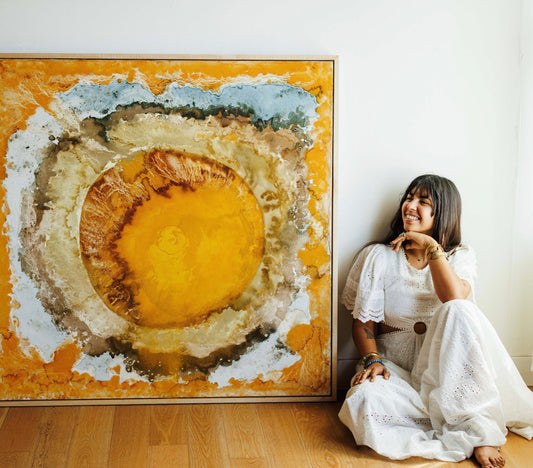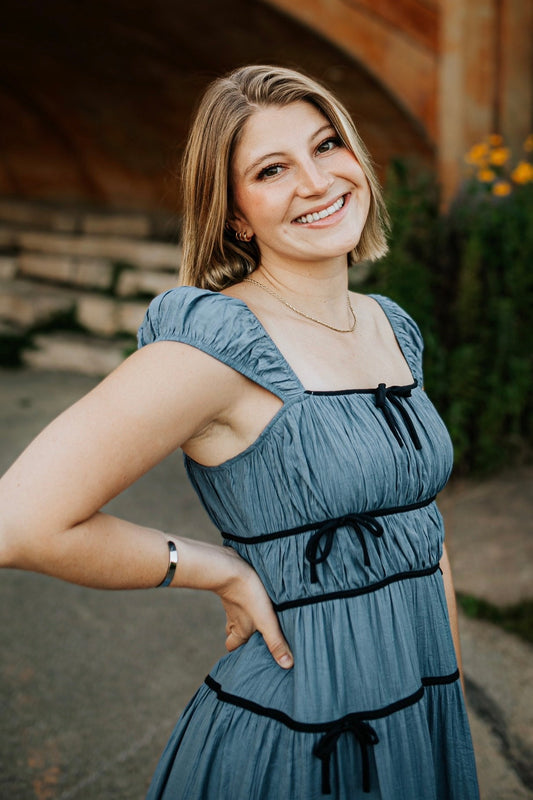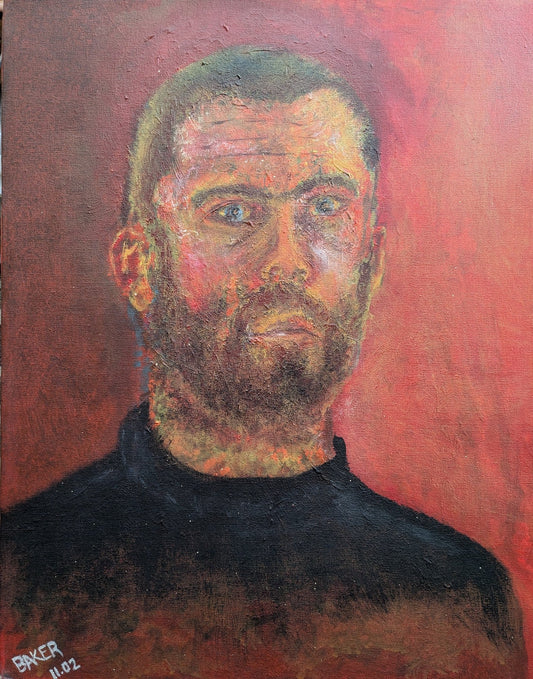Feature image: Debbie Sandoval-Harris courtesy of the artist
Debbie Sandoval-Harris
Amidst the landscapes and animal paintings that saturate Eastern Idaho's growing art community, a handful of abstract artists are paving the way for the future of art in small towns. One such artist is Debbie Sandoval-Harris, a mixed-media, large-scale artist whose bright works immediately draw the viewer in.
Art has always played a significant role in Debbie Sandoval-Harris’s life. Growing up, her grandpa, a watercolor artist, influenced her. She and her sister had art competitions with each other, and she always took art classes in school. In her early artistic pursuits, her work was figurative. Still, when her grandpa influenced her, Sandoval-Harris got to college, where she could explore abstract art through a new lens; her art style shifted away from representational work to the abstract world.
“It (abstraction) was a lot more freeing.”

Her abstract works are filled with bright colors and textures that invite a more profound exploration of her pieces. When creating her work, Sandoval-Harris begins with one color and lets it build from there. She starts with a very loose mark marking and enables the piece to grow. She speaks to her as she goes.
“I try to think about composition and creating rhythm.” She shared that her ADD also influences her art process. “I start getting bored with just using one medium. By including different mediums in my work, it helps me stay more involved in one piece.”

Her abstract works include embroidery, acrylics, crayons, pencils, spray paint, markers, and oil pastels. The bright colors, mixed mediums, and embroidered elements make Sandoval-Harris’s work feel like their own little worlds ready to be explored.
Being surrounded by the figurative artistic community of Eastern Idaho may cause some to wonder how Sandoval-Harris came to prefer abstract art.
She said, “I used to think that abstraction didn’t take talent. After taking an art history class where we covered abstract work and talked about how it was a movement away from representational work and cameras. I thought that was interesting. It pushed me to start trying it, and I took a liking to it. It takes a lot of thinking about the composition.”

She found herself drawn to the works of Helen Frankenthaler and David Hockney and attributes her use of bright colors to her love of Hockney’s work. Sandoval-Harris also shared that her use of bright colors has been influenced by David Bachelor’s book Chromophobia.
“It talks about how people are scared of color and how color is considered feminine, queer, and oriental. Things that are shunned by the Western world. That’s kind of why I use bright colors. My paintings are very energetic, and I want to embrace that.”

Feminism and femininity have played an essential role in Sandoval-Harris’s artist career and are a common thread throughout all her works. Her current abstract pieces embrace femininity through the use of embroidered fiber elements. Fiber arts like embroidery have long been shunted to the side and placed in the realm of women’s work and craft. By actively adding fiber elements to her abstract works, Sandoval-Harris rejects this and elevates fiber arts to fine art status.
She shared, “I like the texture it (the embroidery) adds. I can lead the viewers through the work. I also like the surprise of it. People don’t often notice its embroidery until they get closer to it. It's merging craft and high art together.”

Sandoval-Harris shared that her work has also been heavily influenced by her own children and the concept of childlike insouciance. She was inspired by the way her children created freely and their ability to take pride in whatever they made.
“It's special being able to watch kids create. It made me realize that I don’t have to be so critical of my work. Kids don’t think too hard about it. They just have fun with it and make it about play instead of being critical.” She mused, “Where is that point that we lose that pride of creating and just being happy with what we are making.”

Sandoval-Harris hopes to capture this freedom and joy in her work. She shared that she often has her children doing their own artwork next to her when she is painting, and this allows her to feed off of their joyful and carefree energy.
The concept of childlike insouciance is most readily explored in Sandoval-Harris’s work Childhood Compilation. In this piece, Sandoval-Harris reverts her artistic hand back to her childhood abilities. The work is split into five panels each showing different stages of a child's drawing abilities. From simple scribbles to a yellow sun overlooking a red house and tree.
She shared, “It was just me thinking about how kids work and the stages of children’s drawings. It starts off with just smacking the page with a pen and making marks, and then it gets more figurative as they get older. I was mimicking that. It was actually really hard to do. When you draw a circle, you want to draw a perfect circle, and trying to make it not match was hard. It was fun but difficult to try and replicate as an adult.”

The five different panels of the work appear layered on top of each other as if they have been hung on a fridge and feel reminiscent of youth.
To viewers of her work, Sandoval-Harris shared,
“I hope they (viewers of her work) get that feeling of being a child. The fun of it, the playfulness of it. To not be so scared of color. I’ve had people say, ‘If you did that in a more neutral palette I would buy it’ but I don’t do it that way. I tried one time, but it just didn’t feel right. I can’t do it. It doesn’t give the same feeling when you use duller shades.”
Debbie Sandoval-Harris’s works are a bright and refreshing spot in a small town with a growing art community.
©ArtRKL™️ LLC 2021-2024. All rights reserved. This material may not be published, broadcast, rewritten or redistributed. ArtRKL™️ and its underscore design indicate trademarks of ArtRKL™️ LLC and its subsidiaries.





